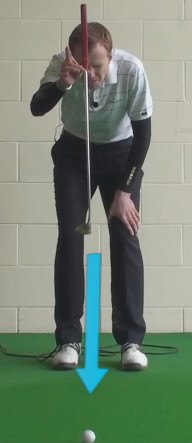Plumb-bobbing is a technique used by golfers to help align their putts. It involves holding the putter in front of the golfer's eyes and using the shaft as a plumb line to determine the slope and break of the green. Here's why and how to plumb-bob a putt:
- Understanding the Break: Plumb-bobbing is most effective when you're trying to read the slope and break of a putt. By using the putter as a plumb line, you can visualize the direction in which the ball will break.
- Aligning Your Body: Plumb-bobbing can also help you align your body properly to the target line. By standing behind the ball and using the putter as a reference, you can ensure that your shoulders, hips, and feet are parallel to the intended line of the putt.
Here's how to plumb-bob a putt:
- Stand Behind the Ball: Position yourself directly behind the ball, facing the hole. Take a few moments to observe the slope and contour of the green.
-

Plumb-Bobbing A Putt
Hold the Putter: Hold the putter with your dominant hand (right hand for right-handed golfers) and extend your arm in front of you. Align the putter's shaft with your line of sight, using it as a plumb line.
- Find the Vertical Alignment: As you look down the shaft of the putter, notice if it appears to be leaning to one side. If the shaft is perfectly vertical, it indicates that the putt has no break. However, if it leans to the right or left, it suggests that the putt will break in that direction.
- Adjust Your Aim: Based on the plumb line, make any necessary adjustments to your aim. If the shaft leans to the right, aim slightly left of the hole to account for the break. If it leans to the left, aim slightly right.
- Repeat for Different Distances: Plumb-bobbing can be used for putts of various distances. Simply repeat the process for each putt, adjusting your aim and visualizing the break.
PGA Pros That Used Plumb-Bobbing
Plumb-bobbing is a putting technique that has been used by many golfers over the years. While it's difficult to provide an exhaustive list of all the golfers who have employed this method, here are a few notable examples:
- Ben Crenshaw: Ben Crenshaw, a two-time Masters champion, was known for his meticulous approach to putting. He was a firm believer in the plumb-bob technique and used it extensively to read greens and align his putts.
- Jack Nicklaus: Jack Nicklaus, considered one of the greatest golfers of all time, was also known to use the plumb-bob method on occasion. Nicklaus was renowned for his ability to read greens and his attention to detail when it came to putting.
- Tom Kite: Tom Kite, a US Open champion and member of the World Golf Hall of Fame, was another golfer who used the plumb-bob technique. Kite was known for his precision on the greens and often relied on plumb-bobbing to help him read putts.
- Brad Faxon: Brad Faxon, a multiple PGA Tour winner and one of the best putters of his era, was known to use the plumb-bob technique. Faxon had a meticulous approach to putting and experimented with various methods to gain an edge on the greens.
- Adam Scott: Adam Scott, the former world number one and Masters champion, has also been known to employ the plumb-bob method at times. Scott is recognized for his smooth putting stroke and attention to detail, and he has used plumb-bobbing to aid in his green reading.
Plumb-bobbing can be used for both long putts and short putts, depending on the golfer's preference and the specific situation. Here's a breakdown of how plumb-bobbing can be applied to different types of putts:
- Long putts: Plumb-bobbing can be particularly useful for long putts where accurately reading the slope and break of the green is crucial. By using the plumb-bob technique, golfers can align their putter's shaft with the intended line of the putt and get a better sense of the overall slope and break. This can help them make a more informed decision on speed and direction.
- Short putts: While plumb-bobbing is commonly associated with longer putts, some golfers may also use it for shorter putts to reinforce their alignment and gain confidence. By utilizing the plumb-bob method, golfers can ensure that their eyes are directly over the target line and their putter face is square to the desired path. This can help reduce alignment errors and promote a more consistent putting stroke.
It's worth mentioning that plumb-bobbing is a personal preference, and not all professional golfers use this technique. Some golfers may find it helpful in certain situations or on specific greens, while others may rely on different methods or simply rely on their instincts and experience to read putts.
Ultimately, the decision to use the plumb-bob technique is up to the individual golfer. It's important to experiment with different putting methods and find what works best for your own game.
Also note that plumb-bobbing is a technique that requires practice and experimentation to develop a feel for reading putts accurately. Additionally, green conditions, such as grain and slope, can influence the effectiveness of this method. Therefore, it's recommended to combine plumb-bobbing with other putting techniques and strategies to enhance your overall putting proficiency.






